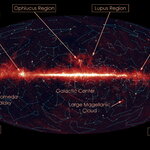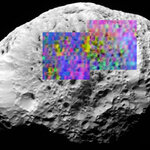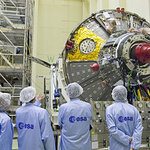Space
Dr. Giovanna Tinetti ( read her interview with Scientific Blogging's Douglas Blane here ) of the European Space Agency and UCL’s Department of Physics & Astronomy has discovered that a planet passing in front of its ‘sun’ absorbs starlight in a way that can only be explained by the presence of water vapour in its atmosphere. This is the first time that astronomers have been able to confirm that water is present on an extra-solar planet.
‘Extra-solar’ planets are those outside our Solar System and more than 200 have been discovered orbiting stars close to our own Sun. The planet with water…

One year after the beginning of its scientific operations, the high-capability infrared satellite AKARI continues to produce stunning views of the infrared Universe.
Launched in February 2006, AKARI is making a comprehensive, multi-wavelength study of the sky in infrared light, helping to gain a deeper understanding of the formation and evolution of galaxies, stars and planetary systems. The mission is a Japan Aerospace Exploration Agency (JAXA) project with ESA and international participation.
In the course of last year, AKARI performed all-sky observations in six wavelength bands. More…

Using natural ‘gravitational lenses’, an international team of astronomers claim to have found a hint of a population of the most distant galaxies yet seen - the light we see from them today left more than 13 thousand million years ago, when the Universe was just 500 million years old.
Team leader Professor Richard Ellis, Steele Professor of Astronomy at Caltech, will present images of these faint and distant objects in his talk on Wednesday 11 July at the ‘From IRAS to Herschel and Planck’ conference at the Geological Society in London. The meeting is being held to celebrate the 65th…

A University of Alabama astronomer has co-developed a new way to characterize galaxy features that is giving scientists additional insight into how galaxies formed and changed over time, according to a paper published in the June 2007 issue of The Astronomical Journal.
Dr. Ronald J. Buta, professor of astronomy at UA, and Dr. Xiaolei Zhang, of the Naval Research Laboratory, Washington, D.C., co-authored the paper detailing the new method of characterizing density wave features in galaxies. Density waves are mass enhancements in galaxies that appear in the forms of spiral arms, linear bar…
Looking at the chemical composition of stars that host planets, astronomers have found that while dwarf stars often show iron enrichment on their surface, giant stars do not. The astronomers think that the planetary debris falling onto the outer layer of the star produces a detectable effect in a dwarf star, but this pollution is diluted by the giant star and mixed into its interior.
"It is a little bit like a Tiramisu or a Capuccino," says Luca Pasquini from ESO, lead-author of the paper reporting the results. "There is cocoa powder only on the top!'
Just a few years after the discovery of…

After a frustrating set of July launch delays, a decision has been made by the Dawn Project to launch Dawn in its September / October launch window.
Update: The September 27 launch was a success!
(The mosaic shows the exhaust trail from Dawn's Delta II launch vehicle superimposed on the sunrise over Cape Canaveral. Photo Credit: Randy Pollock)
What, you haven't heard of Dawn?
You are not alone. NASA's Dawn mission to orbit the asteroids Vesta and Ceres has existed mostly out of the public eye, supported by a small, but dedicated group of scientists and engineers, of whom many…

Mention "outsourcing" and people tend to think of fields like manufacturing or telemarketing; theoretical physics isn't even on the list.
Yet the scientists who develop theoretical predictions for high-energy particle physics experiments say "outsourcing" in their field has allowed the U.S. to lag behind in this area of high-profile, global science.
"This is the wrong kind of outsourcing," says Ulrich Baur, Ph.D., professor of physics in the University at Buffalo College of Arts and Sciences and a co-founder of the Large Hadron Collider-Theory Initiative.
LHC-TI is a consortium of…

NASA's Cassini spacecraft has revealed for the first time surface details of Saturn's moon Hyperion, including cup-like craters filled with hydrocarbons that may indicate more widespread presence in our solar system of basic chemicals necessary for life.
Hyperion yielded some of its secrets to the battery of instruments aboard Cassini as the spacecraft flew close by in September 2005. Water and carbon dioxide ices were found, as well as dark material that fits the spectral profile of hydrocarbons.
This map shows the composition of a portion of Hyperion's surface. Blue shows the maximum…
Hundreds of thousands of vibrant blue and red stars are visible in this new image of galaxy NGC 4449 taken by the NASA/ESA Hubble Space Telescope. Hot bluish white clusters of massive stars are scattered throughout the galaxy, interspersed with numerous dustier reddish regions of current star formation. Massive dark clouds of gas and dust are silhouetted against the flaming starlight.
NGC 4449 has been forming stars since several billion years ago, but currently it is experiencing a star formation event at a much higher rate than in the past. This unusual explosive and intense star formation…

Jules Verne is the first of five ATVs ESA plans to use to send cargo to the Station. The development, production and launch of the first vehicle have cost over 11 years around 1.3 billion Euros. Each of the following ATVs assembly and launch will cost just over 300 million Euros. In this way Europe will pay for utilisation of the ISS, which includes conducting scientific experiments and astronaut missions.
'ATV is much more that a spaceship', emphasises ATV Project Manager John Ellwood with justified pride. 'It is a cargo ship, a laboratory, a rocket and two spacecrafts all in one. The…